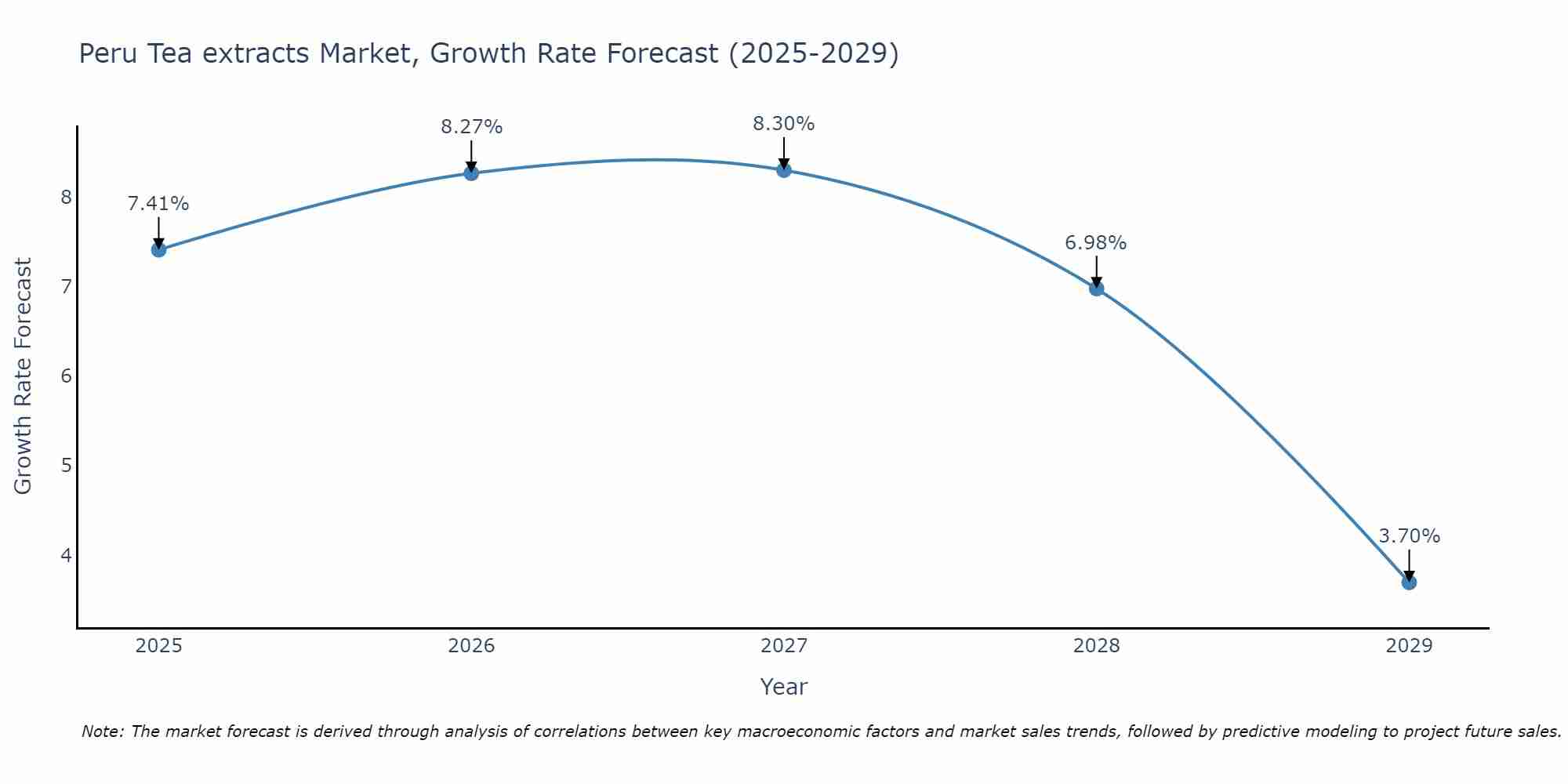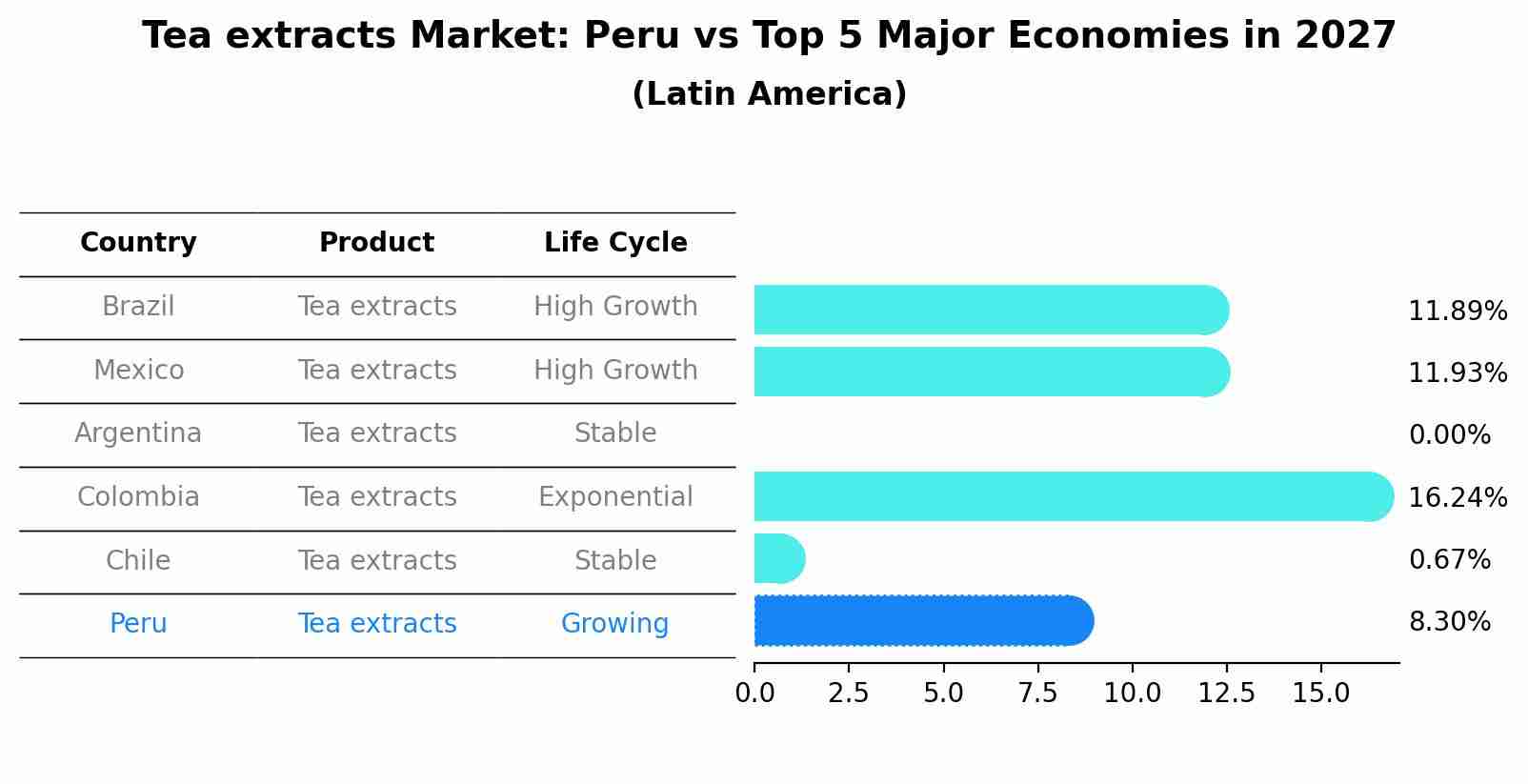Peru Tea extracts Market Outlook | Trends, Revenue, Size, Companies, Analysis, Share, COVID-19 IMPACT, Growth, Industry, Forecast & Value
| Product Code: ETC108805 | Publication Date: Jun 2021 | Updated Date: Jun 2025 | Product Type: Report | |
| Publisher: 6Wresearch | Author: Shubham Padhi | No. of Pages: 70 | No. of Figures: 35 | No. of Tables: 5 |
Peru Tea extracts Market Size Growth Rate
The Peru Tea extracts Market is projected to witness mixed growth rate patterns during 2025 to 2029. The growth rate begins at 7.41% in 2025, climbs to a high of 8.30% in 2027, and moderates to 3.70% by 2029.

Tea extracts Market: Peru vs Top 5 Major Economies in 2027 (Latin America)
By 2027, the Tea extracts market in Peru is anticipated to reach a growth rate of 8.30%, as part of an increasingly competitive Latin America region, where Brazil remains at the forefront, supported by Mexico, Argentina, Colombia and Chile, driving innovations and market adoption across sectors.

Peru Tea extracts Market Overview
The Peru tea extracts market is experiencing significant growth driven by increasing consumer awareness about the health benefits of tea, such as antioxidants and anti-inflammatory properties. The market is characterized by a wide variety of tea extracts, including green tea, black tea, and herbal teas like chamomile and peppermint. Peru`s rich biodiversity offers a unique range of tea ingredients, attracting the attention of both domestic and international buyers. The market is also benefiting from the growing trend towards natural and organic products, with consumers seeking clean label options. Key players in the Peru tea extracts market are focusing on product innovation, sustainable sourcing practices, and expanding distribution channels to capitalize on the increasing demand for tea extracts in food, beverage, and cosmetic industries.
Peru Tea extracts Market Trends
In the Peru tea extracts market, there is a growing demand for organic and natural products as consumers become more health-conscious. This trend is driven by the increasing awareness of the health benefits associated with tea extracts, such as antioxidants and anti-inflammatory properties. Additionally, there is a rising interest in unique and premium tea varieties from Peru, such as coca tea and muña tea, known for their traditional medicinal properties and exotic flavors. Another prominent trend is the incorporation of tea extracts in various food and beverage products, including functional drinks, snacks, and beauty products, to cater to the expanding market for wellness and beauty-enhancing products. Companies in the Peru tea extracts market are focusing on product innovation, sustainable sourcing practices, and marketing strategies to capitalize on these trends and meet consumer preferences.
Peru Tea extracts Market Challenges
In the Peru tea extracts market, some challenges faced include limited awareness among consumers about the benefits of tea extracts, competition from other herbal products, and fluctuations in raw material prices. Additionally, regulatory issues and quality control concerns can also pose challenges for companies operating in this market. Developing innovative products to stand out in a saturated market, ensuring sustainable sourcing practices, and effectively marketing the health benefits of tea extracts are key strategies that companies in Peru may need to focus on to overcome these challenges and drive growth in the tea extracts market.
Peru Tea extracts Market Investment Opportunities
The Peru tea extracts market presents promising investment opportunities due to the increasing consumer interest in natural and healthy products. With a growing awareness of the health benefits associated with tea consumption, there is a rising demand for tea extracts as functional ingredients in various industries such as food and beverage, cosmetics, and pharmaceuticals. Investors can explore opportunities in tea extract production, distribution, and product development to cater to this growing market. Additionally, the rich biodiversity of Peru offers a wide variety of unique tea plant species that can be leveraged to create premium and differentiated tea extract products. Collaborations with local farmers and sustainable sourcing practices can further enhance the market potential for Peru tea extracts.
Peru Tea extracts Market Government Policy
In Peru, the government has implemented various policies related to the Tea extracts Market to promote growth and ensure consumer safety. These policies include regulations on the cultivation, processing, and export of tea extracts to maintain quality standards and protect the environment. Additionally, there are policies in place to support small tea producers through financial assistance and technical training programs. The government also encourages research and development in the tea industry to drive innovation and improve product offerings. Overall, the regulatory framework aims to create a sustainable and competitive market for tea extracts in Peru, promoting both economic development and environmental conservation.
Peru Tea extracts Market Future Outlook
The Peru tea extracts market is expected to witness steady growth in the coming years due to increasing consumer awareness about the health benefits of tea extracts, such as antioxidants and potential weight management properties. The growing trend of natural and organic products is also likely to drive the market as consumers seek healthier alternatives. Additionally, the rising popularity of traditional Peruvian teas like coca tea and muña tea is expected to contribute to market growth. With a focus on sustainability and ethical sourcing, Peru is well-positioned to capitalize on the global demand for high-quality tea extracts. However, challenges such as fluctuating raw material prices and competition from other tea-producing regions may impact market growth to some extent. Overall, the Peru tea extracts market is poised for expansion, driven by consumer preferences for natural and functional ingredients.
Key Highlights of the Report:
- Peru Tea extracts Market Outlook
- Market Size of Peru Tea extracts Market, 2021
- Forecast of Peru Tea extracts Market, 2027
- Historical Data and Forecast of Peru Tea extracts Revenues & Volume for the Period 2018 - 2027
- Peru Tea extracts Market Trend Evolution
- Peru Tea extracts Market Drivers and Challenges
- Peru Tea extracts Price Trends
- Peru Tea extracts Porter's Five Forces
- Peru Tea extracts Industry Life Cycle
- Historical Data and Forecast of Peru Tea extracts Market Revenues & Volume By Type for the Period 2018 - 2027
- Historical Data and Forecast of Peru Tea extracts Market Revenues & Volume By Green tea for the Period 2018 - 2027
- Historical Data and Forecast of Peru Tea extracts Market Revenues & Volume By Black tea for the Period 2018 - 2027
- Historical Data and Forecast of Peru Tea extracts Market Revenues & Volume By Oolong tea for the Period 2018 - 2027
- Historical Data and Forecast of Peru Tea extracts Market Revenues & Volume By Others for the Period 2018 - 2027
- Historical Data and Forecast of Peru Tea extracts Market Revenues & Volume By Application for the Period 2018 - 2027
- Historical Data and Forecast of Peru Tea extracts Market Revenues & Volume By Food for the Period 2018 - 2027
- Historical Data and Forecast of Peru Tea extracts Market Revenues & Volume By Beverages for the Period 2018 - 2027
- Historical Data and Forecast of Peru Tea extracts Market Revenues & Volume By Pharmaceuticals for the Period 2018 - 2027
- Historical Data and Forecast of Peru Tea extracts Market Revenues & Volume By Cosmetics for the Period 2018 - 2027
- Historical Data and Forecast of Peru Tea extracts Market Revenues & Volume By Category for the Period 2018 - 2027
- Historical Data and Forecast of Peru Tea extracts Market Revenues & Volume By Organic for the Period 2018 - 2027
- Historical Data and Forecast of Peru Tea extracts Market Revenues & Volume By Conventional for the Period 2018 - 2027
- Historical Data and Forecast of Peru Tea extracts Market Revenues & Volume By Form for the Period 2018 - 2027
- Historical Data and Forecast of Peru Tea extracts Market Revenues & Volume By Liquid for the Period 2018 - 2027
- Historical Data and Forecast of Peru Tea extracts Market Revenues & Volume By Powder for the Period 2018 - 2027
- Historical Data and Forecast of Peru Tea extracts Market Revenues & Volume By Distribution Channel for the Period 2018 - 2027
- Historical Data and Forecast of Peru Tea extracts Market Revenues & Volume By Store Based for the Period 2018 - 2027
- Historical Data and Forecast of Peru Tea extracts Market Revenues & Volume By Non-Store Based for the Period 2018 - 2027
- Peru Tea extracts Import Export Trade Statistics
- Market Opportunity Assessment By Type
- Market Opportunity Assessment By Application
- Market Opportunity Assessment By Category
- Market Opportunity Assessment By Form
- Market Opportunity Assessment By Distribution Channel
- Peru Tea extracts Top Companies Market Share
- Peru Tea extracts Competitive Benchmarking By Technical and Operational Parameters
- Peru Tea extracts Company Profiles
- Peru Tea extracts Key Strategic Recommendations
Frequently Asked Questions About the Market Study (FAQs):
- Single User License$ 1,995
- Department License$ 2,400
- Site License$ 3,120
- Global License$ 3,795
Search
Thought Leadership and Analyst Meet
Our Clients
Related Reports
- Canada Oil and Gas Market (2026-2032) | Share, Segmentation, Value, Industry, Trends, Forecast, Analysis, Size & Revenue, Growth, Competitive Landscape, Outlook, Companies
- Germany Breakfast Food Market (2026-2032) | Industry, Share, Growth, Size, Companies, Value, Analysis, Revenue, Trends, Forecast & Outlook
- Australia Briquette Market (2025-2031) | Growth, Size, Revenue, Forecast, Analysis, Trends, Value, Share, Industry & Companies
- Vietnam System Integrator Market (2025-2031) | Size, Companies, Analysis, Industry, Value, Forecast, Growth, Trends, Revenue & Share
- ASEAN and Thailand Brain Health Supplements Market (2025-2031) | Strategy, Consumer Insights, Analysis, Investment Trends, Opportunities, Growth, Size, Share, Industry, Revenue, Segments, Value, Segmentation, Supply, Forecast, Restraints, Outlook, Competition, Drivers, Trends, Demand, Pricing Analysis, Competitive, Strategic Insights, Companies, Challenges
- ASEAN Bearings Market (2025-2031) | Strategy, Consumer Insights, Analysis, Investment Trends, Opportunities, Growth, Size, Share, Industry, Revenue, Segments, Value, Segmentation, Supply, Forecast, Restraints, Outlook, Competition, Drivers, Trends, Demand, Pricing Analysis, Competitive, Strategic Insights, Companies, Challenges
- Europe Flooring Market (2025-2031) | Outlook, Share, Industry, Trends, Forecast, Companies, Revenue, Size, Analysis, Growth & Value
- Saudi Arabia Manlift Market (2025-2031) | Outlook, Size, Growth, Trends, Companies, Industry, Revenue, Value, Share, Forecast & Analysis
- Uganda Excavator, Crane, and Wheel Loaders Market (2025-2031) | Strategy, Consumer Insights, Analysis, Investment Trends, Opportunities, Growth, Size, Share, Industry, Revenue, Segments, Value, Segmentation, Supply, Forecast, Restraints, Outlook, Competition, Drivers, Trends, Demand, Pricing Analysis, Competitive, Strategic Insights, Companies, Challenges
- Rwanda Excavator, Crane, and Wheel Loaders Market (2025-2031) | Strategy, Consumer Insights, Analysis, Investment Trends, Opportunities, Growth, Size, Share, Industry, Revenue, Segments, Value, Segmentation, Supply, Forecast, Restraints, Outlook, Competition, Drivers, Trends, Demand, Pricing Analysis, Competitive, Strategic Insights, Companies, Challenges
Industry Events and Analyst Meet
Whitepaper
- Middle East & Africa Commercial Security Market Click here to view more.
- Middle East & Africa Fire Safety Systems & Equipment Market Click here to view more.
- GCC Drone Market Click here to view more.
- Middle East Lighting Fixture Market Click here to view more.
- GCC Physical & Perimeter Security Market Click here to view more.
6WResearch In News
- Doha a strategic location for EV manufacturing hub: IPA Qatar
- Demand for luxury TVs surging in the GCC, says Samsung
- Empowering Growth: The Thriving Journey of Bangladesh’s Cable Industry
- Demand for luxury TVs surging in the GCC, says Samsung
- Video call with a traditional healer? Once unthinkable, it’s now common in South Africa
- Intelligent Buildings To Smooth GCC’s Path To Net Zero


















